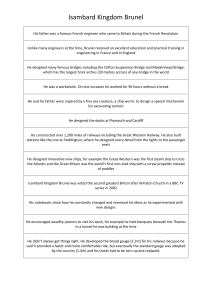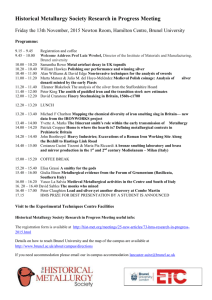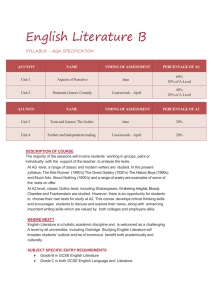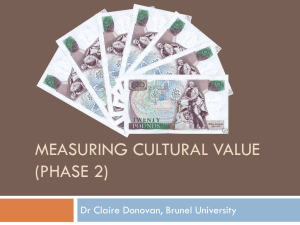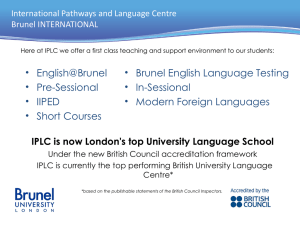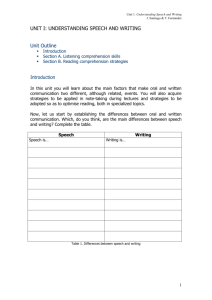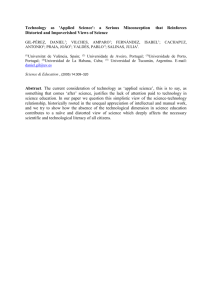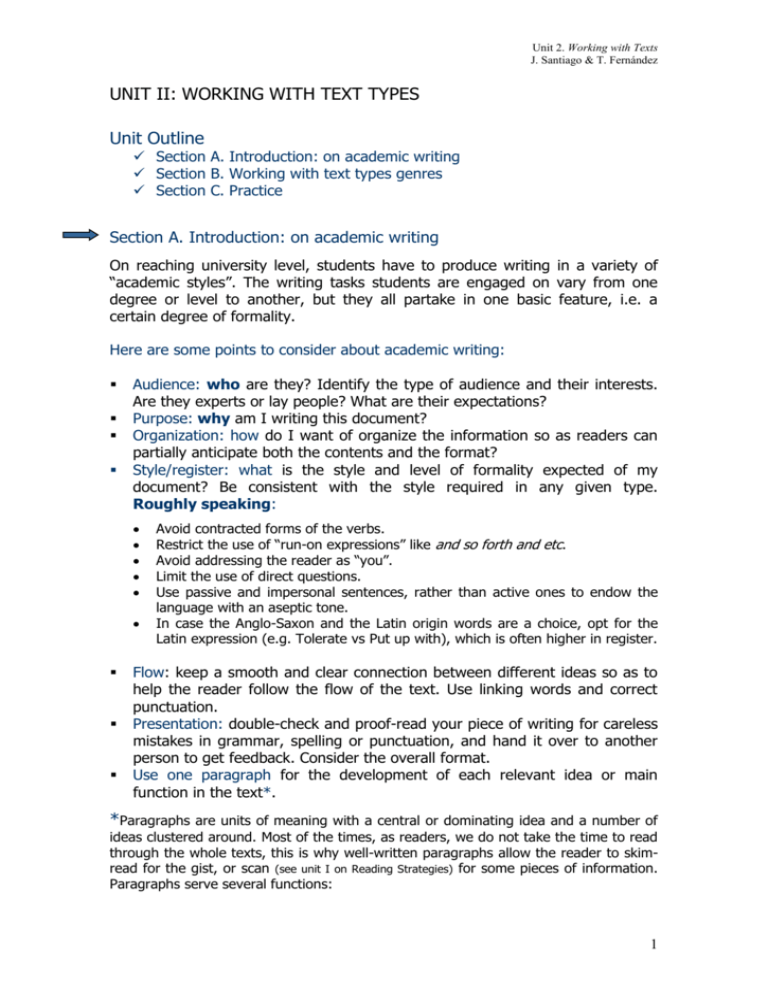
Unit 2. Working with Texts
J. Santiago & T. Fernández
UNIT II: WORKING WITH TEXT TYPES
Unit Outline
Section A. Introduction: on academic writing
Section B. Working with text types genres
Section C. Practice
Section A. Introduction: on academic writing
On reaching university level, students have to produce writing in a variety of
“academic styles”. The writing tasks students are engaged on vary from one
degree or level to another, but they all partake in one basic feature, i.e. a
certain degree of formality.
Here are some points to consider about academic writing:
Audience: who are they? Identify the type of audience and their interests.
Are they experts or lay people? What are their expectations?
Purpose: why am I writing this document?
Organization: how do I want of organize the information so as readers can
partially anticipate both the contents and the format?
Style/register: what is the style and level of formality expected of my
document? Be consistent with the style required in any given type.
Roughly speaking:
Avoid contracted forms of the verbs.
Restrict the use of “run-on expressions” like and so forth and etc.
Avoid addressing the reader as “you”.
Limit the use of direct questions.
Use passive and impersonal sentences, rather than active ones to endow the
language with an aseptic tone.
In case the Anglo-Saxon and the Latin origin words are a choice, opt for the
Latin expression (e.g. Tolerate vs Put up with), which is often higher in register.
Flow: keep a smooth and clear connection between different ideas so as to
help the reader follow the flow of the text. Use linking words and correct
punctuation.
Presentation: double-check and proof-read your piece of writing for careless
mistakes in grammar, spelling or punctuation, and hand it over to another
person to get feedback. Consider the overall format.
Use one paragraph for the development of each relevant idea or main
function in the text*.
*Paragraphs are units of meaning with a central or dominating idea and a number of
ideas clustered around. Most of the times, as readers, we do not take the time to read
through the whole texts, this is why well-written paragraphs allow the reader to skimread for the gist, or scan (see unit I on Reading Strategies) for some pieces of information.
Paragraphs serve several functions:
1
Unit 2. Working with Texts
J. Santiago & T. Fernández
Help reader follow the flow of ideas and their sequence in an orderly manner.
Break up the visual monotony and improve the global appearance.
Contribute to the global coherence of the text by holding different logical
relations among them, and with the whole text, such as addition (besides,
additionally, in addition), instantiation (that is, for instance), cause & effect
(consequently, thus), time (first, second, then) and space relations, comparison
or conclusion (in short, finally).
Additionally, paragraphs can be developed in two ways:
Deductive development: first & most important information at the beginning. This type
of structure favors smooth flow of ideas. To do so, you have to:
1. Introduce statement in the first sentence.
2. Provide background to support the statement.
3. Conclude with a second statement linked to the first.
Inductive development: mainly when we wish to argue for/against an argument, or
simply to temper or delay bad news until the end. To do so, you have to:
1.
2.
3.
4.
Orient the reader and prepare for later development.
Present data and supporting arguments in a logical way.
Make your point based on the prior.
Conclude with the central statement by way of conclusion or with a counterargument to a previous statement if we want to refute it.
Section B. Working with text types and genres
The analysis of any piece of written information can be carried out in different ways
depending on our aim and expectations about the text. Two basic approaches can be
adopted to disclose the inner ‘texture’ of a text, namely, the “top-down” approach and
the “bottom-up” approach. The first one consists in getting the overall organization of
the text drawing on specific content and structure conventions (macro-level). Thus, we
are familiar with the differences between a newspaper article, a formal letter, a PhD
dissertation, the beginning of a novel, an abstract, or an instructions manual. On the
other hand, the bottom-up (micro-level) approach is based on the analysis of the
different components of the text, like the choice of words or syntax. Very often, both
levels are at play simultaneously. These different discourse manifestations are known
as discourse modes or genres. Genres should be distinguished from text types
(narrative, descriptive, expository and argumentative; see unit I). Text types operate
at linguistic level, whereas genres are mostly shaped by cultural (academic and
professional) convention.
Write a tick next to the genre in the table that you often know/ write or read:
Summaries (& abstracts)
Journal paper
Formal e mailing
Report
Specifications
Essay
PhD dissertation
Cover letters
Resume/Curriculum vitae
Instructions
In this unit, we will work with summaries (& abstracts), formal e-mailing,
memos and specifications.
2
Unit 2. Working with Texts
J. Santiago & T. Fernández
A SUMMARY is a re-elaboration of a text keeping the “spirit” and capturing
the most important ideas in a much shorter space. Writing a good summary is
far from being an easy task. In order to write a good summary you need to
understand the source text, analyse its central idea, its key points and writer’s
purpose, and then be able to express it in your own words as clear, brief and
accurate as possible. Here are some of the points to be considered when doing
this task:
Do not start by “the text is about...”
Provide a balanced coverage of the original.
Present information in a neutral way. Be objective. Do not express your own
views on the topic.
Recreate the source in your own words avoiding paraphrasing or copying.
Do not improve the source by adding “your information”.
Go to the essentials. Leave out redundant, unnecessary details. Do not include
quotes “...”, specific data or figures unless highly relevant.
When writing the summary, you may follow these steps:
Read the text once.
Read the text twice underlying parts you deem important.
Underlying is to be selective and hierarchical. Underlined chunks should make
sense in themselves and among them providing a global coherence.
Take notes on the margins.
Write a draft: summary result does not have to keep original
paragraph/information sequencing.
As well as the general summary type stated above, there are also other types of
more specialized summaries, namely: the executive summary and the abstract.
THE EXECUTIVE SUMMARY is a condensed version of a longer text,
often 10% of the source. This document is written for executives who most
likely don’t have the time to read the original document in full. An executive
summary does not include procedural details, to be found in the original
document, but it includes a concise statement, a recommendation with
some specific course of action.
AN ABSTRACT is a summary (in about 250 words) that must appear as
the first section of journal articles. Abstracts are sent to conference
organizers, who will then hand them over to the reviewers. The
(anonymous) reviewers will decide whether your work is accepted into the
conference or symposium or not. In case the abstract is accepted, the
organization will often ask you to submit the full article within a specific
deadline. Abstracts often have the following linguistic features:
Informative and oriented to results.
The use of full sentences.
The use of present and past simple tenses.
The use of the “impersonal passive”.
3
Unit 2. Working with Texts
J. Santiago & T. Fernández
Absence of negative sentences.
Avoidance of abbreviations, jargon, symbols unless shared by the readership.
Often written in one full paragraph.
Abstracts must have a “wholeness” to them.
An abstract follows the internal structure:
Background (revision of previous relevant studies in the field)
Objective/s (the goals of the study)
Methodology (the way research has been conducted)
Results (obtained from the analysis)
Discussion and conclusions
THE MEMO (-ramdum), or short informal report, is a short single-spaced
document usually among members of one organization/company; they are
mainly written to:
note the existence of a problem
propose some course of action
describe a new procedure (“progress report”)
report on the results of a test/investigation
Memos follow the structure:
HEADING:
To:
From:
Subject:
DATE: write it so as to avoid ambiguity, i.e. Feb 4, 2010
FOREWORD: statement of topic
SUMMARY: including results and most relevant information<
DETAILS: - provide information from general-to-specific
- propose some course of action
THE FORMAL E-MAIL. E-mail started in 1965 as a way for multiple timesharing electronic communication. It was quickly extended to become network
e-mail, allowing users to pass messages between different computers.
Nowadays, e mailing is considered a hybrid genre because it shares features of
written language while adopting the dynamic structure of oral communication.
In e mailing, the layout is pre-designed for us, although there are some
important points to bear in mind:
Signature
This is like the signature block in a letter, although it usually includes more details, e.g.
the sender’s company or private address, and telephone and fax numbers. As you may
know, you can program your email software to add your signature automatically to the
end of outgoing messages.
4
Unit 2. Working with Texts
J. Santiago & T. Fernández
Style
E mail is a relatively recent development, being perceived as a quick and informal
means of communication. However, people are often unclear about the style and
conventions they should use in business situations. As a general rule, although email
correspondence may tend towards informality, it should follow the same principles as
any other form of business correspondence.
Here are some basic tips about style and content:
-
-
-
-
-
In general email messages follow the style and conventions used in letters or faxes.
You may use salutations such as: Dear Mr…, Dear Jane, and complimentary closes,
such as: Yours sincerely, Best wishes.
Do not confuse personal messages with business messages. In a business message use
the same rules as for a letter: write clearly, carefully, and courteously; you should
consider readership, purpose, clarity, consistency, conciseness, and tone.
Use correct grammar, spelling, capitalization, and punctuation, as you would in any
other form of correspondence.
Do not write words in capital letters in an email message. This can be seen as the
equivalent of shouting and therefore has a negative effect. If you want to stress a
word, put asterisks on each side of it, e.g. *urgent*.
Keep your email message short and to the point.
It is always advisable to send 1 message for 1 topic. This helps to keep the message
brief and makes it easier for the recipient to answer, file and retrieve it later.
Check your email message for mistakes before you send it, just as you would check a
letter or a fax message.
In “second round” emails, it is acceptable to omit the salutation and the complimentary
close when the sender and recipient have exchanged previous messages.
A good email sticks to the subject. Ideally, emails should be visible within one simple
screen-view without scrolling down, and should follow the inverted pyramid content
structure, with most important first and less relevant second. If in need of writing up
more information, break your email into paragraphs which deal with one idea.
Always mail back, even if you have nothing to respond at that particular time. Simply
acknowledge the previous message and say that you will mail again (:“I just read your
message… I’ll get back to you asap”).
Finally, here is a list of some commonly used e mail abbreviations:
ASAP: as soon as possible
BTW: by the way
IOW: in other words
AFAIK: as far as I know
COB: close of business
NRN: no reply necessary
BFN: bye for now
FYI: for your information
OTOH: on the other hand
THE SPECIFICATIONS. Generally speaking, specifications are a list of
items of the work to be done on site during the construction of a building.
Following the definition on Wikipedia, a specification is an explicit set of requirements
to be satisfied by a material, product, or service. Should a material, product or service
fail to meet one or more of the applicable specifications, it may be referred to as being
out of specification; the abbreviation OOS may also be used.
Sometimes the term specification is used in connection with a data sheet (or spec
sheet). A data sheet is usually used for technical communication to describe technical
characteristics of an item or product. It can be published by a manufacturer to help
people choose products or to help use the products.
5
Unit 2. Working with Texts
J. Santiago & T. Fernández
Section C. Practice
1. Read the text below and write a summary in about 100 words observing the
guidelines provided in the unit. Include word-count.
Text I: THE SHOCK OF THE OLD. A London exhibition re-examines the works of the
Victorian Architect Isanbard Brunel (By Kate Noble)
1. When the Centre Georges Pompidou opened 30 years ago, Parisians were shocked.
Architects Renzo Piano and Richard Rogers had left the structure of the museum visible rather
than hiding it in a concrete shell. That bold stroke was the catalyst for a movement in
architecture to make engineering obvious. Today the architects' names are famous, but the
engineers from the Ove Arup partnership are barely known outside their profession. We regard
architects as the creative brains behind our structures; engineers are mere builders.
2. In the 19th century it was different: engineers were famous and immensely respected.
The men who built the infrastructure of the Industrial Revolution — the railways, bridges,
factories — were household names. One of the most innovative and important of them was
Isambard Kingdom Brunel, the designer of some of the landmark achievements of Victorian
Britain's transportation system — many of which still stand today. The breadth of Brunel's vision
can be seen until the end of February at London's Design Museum, where contemporary
architects and engineers have mounted an exhibition to assess his legacy.
3. Born in 1806, Brunel started work when society was eager to extend the uses of new
technologies. Though his suspension bridges and railway stations are today his best-known
works, he designed 125 other bridges, 25 rail lines, three important ships, as well as numerous
docks and piers during a 37-year career.
4. Brunel approached his projects with energy, meticulous research and originality.
Appointed engineer to the Great Western Railway in 1833, he designed every part of the Bristolto-London line, from trackwork — he insisted on a broad 2.14-m gauge — to bridges, stations
and even lampposts. At the London end Brunel produced one of the earliest and most beautiful
of the great railway terminals, Paddington Station, using the then thoroughly modern materials
of iron and glass.
5. Today it is easy to look at the work of the Victorian engineers and forget how innovative
they were. One of Brunel's famous bridges, the Royal Albert at Saltash in Cornwall, showed
how confidently he could produce a revolutionary design — the closed-system suspension
bridge in which all the forces are contained within the structure. The 335-m span blends
compression arches, wrought iron tension chains and a beam deck, a combination that had
never been used on such a scale.
6. If Brunel's bridges remain the most visible of his works, the most important ones are
hidden underwater. His first ship, the wooden-hulled Great Western, propelled by steam-driven
paddle wheels, became the first effective transatlantic steamship. His second marine creation,
the Great Britain, revolutionized shipping with its iron hull and screw propeller. Early forms of
the screw performed inefficiently because they turned too slowly, but Brunel's higher-powered
six-bladed propeller, combined with a balanced rudder, was the key feature of a vessel that has
been called the mother of all modern ships.
7. Brunel nevertheless had his failures. His third ship, the Great Eastern, the first to be
built with a double hull, was so heavy (18,915 tons) and so long (211 m) that it took three
months to launch — sideways. The ship then proved too big for all but a few ports on the trade
route to India, the task for which it was built. His railway designs also had their problems. He
never created a steam locomotive that worked properly, and the broad-gauge track of the Great
Western, though technically sound, was ultimately rejected in favor of the narrower gauge in
use elsewhere.
8. Those failures cannot diminish the importance of Brunel's innovative solutions to
engineering problems, a genius that still inspires designers and architects to push the
boundaries of what is possible, and to do so visibly. And the more they push, the more likely
that engineers will achieve fame — again.
6
Unit 2. Working with Texts
J. Santiago & T. Fernández
2. Look for an abstract dealing with architecture and construction topics and indicate if
it complies with the ‘typical structure’ and content set out for this type of document
end.
3. Write a formal e mail to apply for a scholarship to study abroad. Address your
document to some specific scholarship opportunity by previously searching details on
the Internet.
References
Baily, S. 2006. Academic Writing. A handbook for International Students. Routledge:
London and New york.
Grice, G. and P. Maier. 2007. Effective Study Skills. Unlock your Potential. Pearson
Longman: Harlow.
Santiago, J. and T. Fernández 2010. Notes from Class (2000-2010). Unpublished.
7

